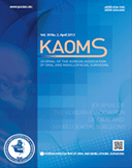Journal of the Korean Association of Oral and Maxillofacial Surgeons
- P-ISSN2234-7550
- E-ISSN2234-5930
- SCOPUS, KCI, ESCI
 ISSN : 2234-7550
ISSN : 2234-7550
A ramus cortical bone harvesting technique without bone marrow invasion
Min-Soo Ghim (Wonkwang University, Iksan, Korea)
Jung Ho Park (Research Institute of Clinical Medicine of Jeonbuk National University)
Dae Ho Leem (Research Institute of Clinical Medicine of Jeonbuk National University)
Abstract
Autogenous bone grafts from the mandibular ramus are a known source of inadequate bone volume scenarios of the residual alveolar ridge. However, the conventional block-type harvesting technique cannot prevent bone marrow invasion, which can cause postoperative complications such as pain, swelling, and inferior alveolar nerve injury. This study aims to suggest a complication-free harvesting technique and present the results of bone grafting and donor sites. One patient received two dental implants with a complication-free harvesting technique that involves creation of ditching holes with a 1 mm round bur. Sagittal, coronal, and axial osteotomies produced grid-type cortical squares using a micro-saw and a round bur to confirm the cortical thickness. The grid-type cortical bone was harvested from the occlusal aspect, and the harvesting was extended through an additional osteotomy on the exposed and remaining cortical bone to prevent bone marrow invasion. The patient did not suffer postoperative severe pain, swelling, or numbness. After 15 months, the harvested site exhibited new cortical bone lining, and the grafted area had healed to a cortico-cancellous complex with functional loading of the implants. Our technique, grid-type cortical bone harvesting without bone marrow invasion, allowed application of autogenous bone without bone marrow invasion to achieve acceptable bone healing of the dental implants and to regenerate the harvested cortical bone.
- keywords
- Autograft, Bone grafting, Dental implant, Mandible, Osteotomy
- 다운로드 수
- 조회수
- 0KCI 피인용수
- 0WOS 피인용수